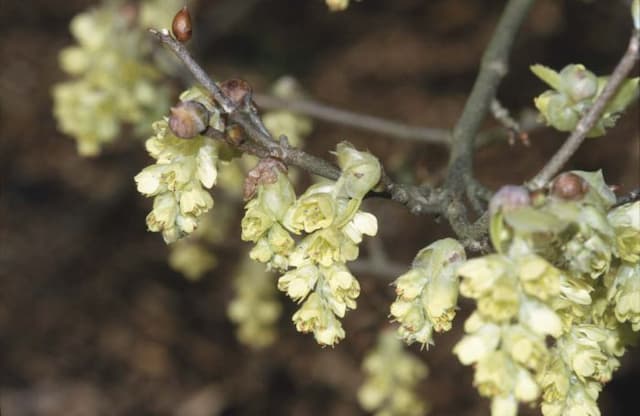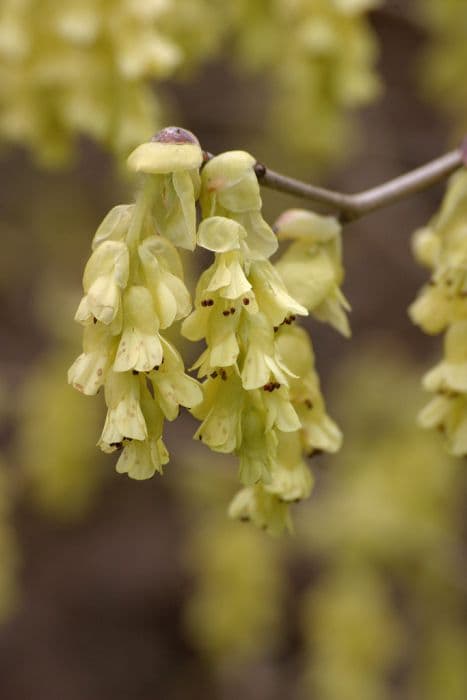Witch Hazel Hamamelis × intermedia 'Advent'

ABOUT
The Hamamelis × intermedia 'Advent' is a type of witch hazel that is known for its captivating winter displays. This particular cultivar stands out with its vibrant blooms. The flowers are unique, with slender, ribbon-like petals that curl and twist in an attractive manner. These blossoms are typically a bright yellow, emanating a cheery glow even on the dreariest winter days. The petals emanate from a central hub, resembling small, spidery suns that cling to the bare branches of the plant. In addition to the striking flowers, the foliage of this witch hazel is also note-worthy. The leaves are broad, with a soft, ovate to round shape that tapers to a point. They display an alluring dark green color during the growing season before transitioning to lovely shades of yellow, orange or red, signaling the arrival of autumn. The bark on this witch hazel is smooth with a gray to brown hue, contributing to the plant's overall aesthetics throughout the year. Even after the leaves fall, the structure of the branches offers a sculptural quality to the landscape. The overall appearance of Hamamelis × intermedia 'Advent' makes it a standout specimen in a garden setting, offering interest across multiple seasons with its vibrant blossoms, colorful leaves, and appealing structure.
About this plant
 Names
NamesFamily
Hamamelidaceae
Synonyms
Hybrid Witch Hazel
Common names
Hamamelis × intermedia 'Advent'.
 Toxicity
ToxicityTo humans
Witch hazel, including the cultivar Hamamelis × intermedia 'Advent', is generally considered non-toxic to humans. There are no well-documented cases of poisoning from ingesting witch hazel. However, as with many plants, individual sensitivities can vary, and ingesting plant material can sometimes lead to gastrointestinal upset or allergic reactions in some individuals. Consuming witch hazel in large quantities is not advised due to the potential for stomach irritation or other adverse effects.
To pets
Witch hazel, including the cultivar Hamamelis × intermedia 'Advent', is generally considered non-toxic to pets as well. It is not known to cause any significant toxic effects if pets happen to ingest parts of the plant. However, ingestion of any non-food plant material can potentially lead to mild stomach upset in some animals. If a pet ingests a large amount of witch hazel, it's always wise to monitor them for signs of gastrointestinal distress and consult with a veterinarian if any adverse symptoms arise.
 Characteristics
CharacteristicsLife cycle
Perennials
Foliage type
Deciduous
Color of leaves
Green
Flower color
Yellow
Height
12 feet (3.66 meters)
Spread
12 feet (3.66 meters)
Plant type
Shrub
Hardiness zones
5
Native area
Japan China
Benefits
 General Benefits
General Benefits- Winter Interest: This hybrid witch hazel blooms in winter, providing vibrant color during a time when few other plants are flowering.
- Attractive Foliage: The plant has distinctive foliage that adds texture and visual interest to garden settings throughout the growing season.
- Fragrant Flowers: The flowers emit a pleasant fragrance, which can be a delight in the otherwise dormant winter garden.
- Wildlife Attraction: The blooms can attract and support pollinators such as bees, even in late winter when few other nectar sources are available.
- Low Maintenance: It is generally considered low maintenance, requiring minimal pruning and care once established.
- Drought Tolerance: Once established, it can be quite tolerant of drought, making it suitable for xeriscaping or gardens with limited water availability.
- Seasonal Color: Beyond its winter flowers, this plant offers attractive autumn leaf colors, adding to its seasonal interest.
 Medical Properties
Medical PropertiesThis plant is not used for medical purposes.
 Air-purifying Qualities
Air-purifying QualitiesThis plant is not specifically known for air purifying qualities.
 Other Uses
Other Uses- Witch Hazel branches are often used in divining rods for water witching, a traditional practice to locate underground water sources.
- The plant's extract can be used as a natural insect repellent, particularly in warding off certain types of pests and mosquitoes.
- Dried Witch Hazel leaves and bark can be used to add a unique flavor in the smoking process of meats, imparting a subtle woody taste.
- The strong wood of Witch Hazel is used in the making of small wooden objects, such as tool handles and mallets, due to its durability and resistance to splitting.
- Witch Hazel's vibrant yellow blooms and lush foliage are used in floral arrangements, particularly in winter when there are fewer flowering plants available.
- Fiber from Witch Hazel can be used in the creation of natural, eco-friendly fabrics, though it's not commonly known for this use.
- The twigs and branches are sometimes used in furniture making for their unique appearance, although this is not a mainstream use.
- Witch Hazel can be used as a natural dye for textiles and crafts, producing delicate yellow to orange hues.
- In larger landscapes or parks, Witch Hazel is used as a natural screen or hedge, offering privacy and seasonal interest.
- The plant's unique forked branches are used in the construction of traditional rustic fencing or garden trellises.
Interesting Facts
 Feng Shui
Feng ShuiThe Witch Hazel is not used in Feng Shui practice.
 Zodiac Sign Compitability
Zodiac Sign CompitabilityThe Witch Hazel is not used in astrology practice.
 Plant Symbolism
Plant Symbolism- Healing and Protection: Since Hamamelis is commonly known as witch hazel, which has medicinal properties, it often symbolizes healing. The plant has been traditionally used for its anti-inflammatory and soothing properties, representing the ability to alleviate pain and protect skin health.
- Resilience and Survival: Witch hazel is notable for its ability to bloom in the winter. Its unique trait of flowering during the coldest months can represent resilience and the ability to endure and thrive during challenging times.
- Unique Beauty: The 'Advent' cultivar of witch hazel is valued for its striking and spidery yellow flowers which bloom in the dead of winter. This symbolizes uniqueness and the beauty that can stand out at unexpected times.
- Fascination and Attraction: The unusual appearance and the timing of the bloom can also symbolize fascination and attracting attention, highlighting the captivating presence one may have regardless of the season.
 Water
WaterThe common name for Hamamelis × intermedia 'Advent' is Witch Hazel. It should be watered deeply and regularly during its first growing season to establish an extensive root system; once established, maintain evenly moist soil. In the absence of rainfall, water about once a week with enough water to soak the soil to the root zone, which typically means 1 to 2 gallons depending on the size of the plant and the environmental conditions. During hot, dry periods, additional water may be needed. Decrease frequency in winter when the plant is dormant.
 Light
LightWitch Hazel thrives in full sun to partial shade. The ideal location would be a spot where it can receive at least four hours of direct sunlight a day, with some protection from intense afternoon sun. Sites with morning sun and dappled afternoon shade are generally well-suited for Witch Hazel.
 Temperature
TemperatureWitch Hazel prefers a temperate climate and is hardy in zones 5 through 8. It can withstand temperatures as low as -20°F during dormancy in winter and is comfortable in summer temperatures up to 90°F. The ideal growing temperatures for Witch Hazel range from 60°F to 75°F.
 Pruning
PruningWitch Hazel should be pruned to maintain its shape and to remove any dead or crossing branches. The best time to prune is in late winter or early spring before new growth starts as it blooms on the previous season's wood. Prune sparingly, as the plant does not require heavy pruning—usually only removing crossed branches and shaping as needed once a year.
 Cleaning
CleaningAs needed
 Soil
SoilWitch hazel prefers well-drained, loamy soil rich in organic matter with a pH of 5.5 to 6.5. A mix of two parts garden soil, one part sand, and one part compost or leaf mold would be ideal for Hamamelis × intermedia 'Advent' to thrive.
 Repotting
RepottingWitch hazel, being a large shrub, does not typically require repotting as it is usually planted directly in the ground. If grown in a container, repotting every 3-5 years or when root bound is sufficient for Hamamelis × intermedia 'Advent'.
 Humidity & Misting
Humidity & MistingWitch hazel does well in average humidity levels and does not require any special humidity considerations for Hamamelis × intermedia 'Advent'. It can be grown successfully in the natural outdoor humidity of its growing zones.
 Suitable locations
Suitable locationsIndoor
Provide bright, indirect light and ensure pot has drainage.
Outdoor
Plant in partial shade, shelter from strong winds, amend soil.
Hardiness zone
5-8 USDA
 Life cycle
Life cycleWitch Hazel 'Advent' starts its life cycle as a seed, which upon successful germination, develops into a seedling with prime leaves. As it grows, the plant enters the vegetative stage, where foliage and roots develop, and it establishes itself. This perennial shrub then reaches maturity and begins the reproductive phase, characterized by the blooming of fragrant yellow flowers typically between mid-winter to early spring. Following pollination, which can involve insects braving the cold or self-fertilization, the flowers develop into seed capsules. The capsules mature by autumn, eventually opening to release seeds, which are dispersed, often by winds or foraging animals. This cycle repeats annually as the plant continues to mature and reach a greater spread and size, at times living for several decades.
 Propogation
PropogationPropogation time
Early spring
The most popular method of propagation for Hamamelis × intermedia 'Arnold Promise', commonly known as Witch Hazel, is by softwood cuttings. This process is usually carried out in late spring or early summer when new growth is mature enough but still soft. A cutting should be about 4 to 6 inches (10 to 15 cm) long and include several leaf nodes. The lower leaves are removed, and the cut end is often treated with a rooting hormone to encourage root development. It is then planted in a well-draining soil mixture and kept in a humid environment with consistent, but not direct, light until roots have formed, which could take several weeks.









